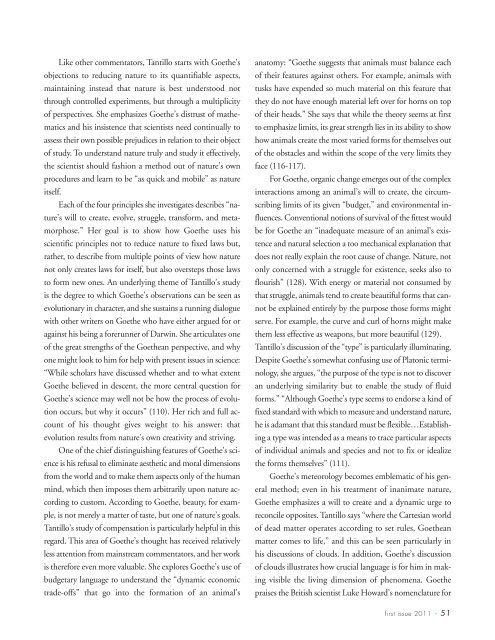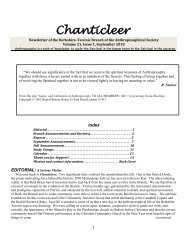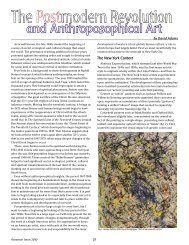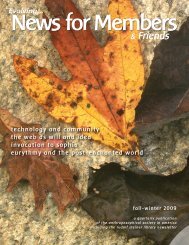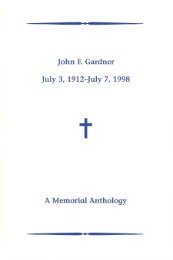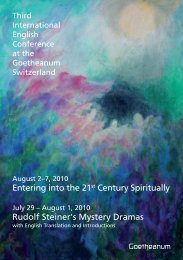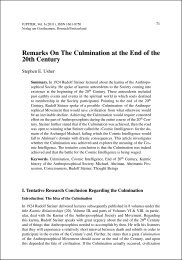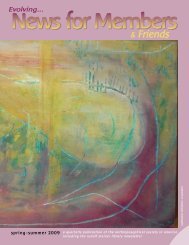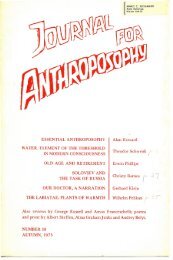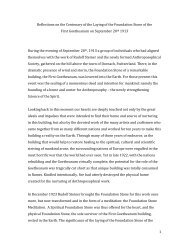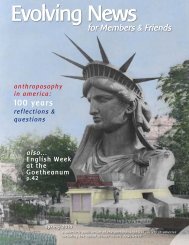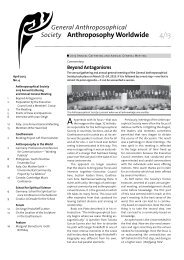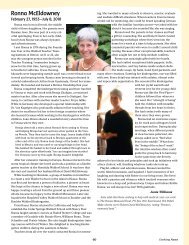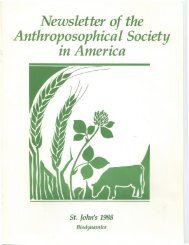Rudolf Steiner's Vision for the Future - Anthroposophical Society in ...
Rudolf Steiner's Vision for the Future - Anthroposophical Society in ...
Rudolf Steiner's Vision for the Future - Anthroposophical Society in ...
You also want an ePaper? Increase the reach of your titles
YUMPU automatically turns print PDFs into web optimized ePapers that Google loves.
Like o<strong>the</strong>r commentators, Tantillo starts with Goe<strong>the</strong>’s<br />
objections to reduc<strong>in</strong>g nature to its quantifiable aspects,<br />
ma<strong>in</strong>ta<strong>in</strong><strong>in</strong>g <strong>in</strong>stead that nature is best understood not<br />
through controlled experiments, but through a multiplicity<br />
of perspectives. She emphasizes Goe<strong>the</strong>’s distrust of ma<strong>the</strong>matics<br />
and his <strong>in</strong>sistence that scientists need cont<strong>in</strong>ually to<br />
assess <strong>the</strong>ir own possible prejudices <strong>in</strong> relation to <strong>the</strong>ir object<br />
of study. To understand nature truly and study it effectively,<br />
<strong>the</strong> scientist should fashion a method out of nature’s own<br />
procedures and learn to be “as quick and mobile” as nature<br />
itself.<br />
Each of <strong>the</strong> four pr<strong>in</strong>ciples she <strong>in</strong>vestigates describes “nature’s<br />
will to create, evolve, struggle, trans<strong>for</strong>m, and metamorphose.”<br />
Her goal is to show how Goe<strong>the</strong> uses his<br />
scientific pr<strong>in</strong>ciples not to reduce nature to fixed laws but,<br />
ra<strong>the</strong>r, to describe from multiple po<strong>in</strong>ts of view how nature<br />
not only creates laws <strong>for</strong> itself, but also oversteps those laws<br />
to <strong>for</strong>m new ones. An underly<strong>in</strong>g <strong>the</strong>me of Tantillo’s study<br />
is <strong>the</strong> degree to which Goe<strong>the</strong>’s observations can be seen as<br />
evolutionary <strong>in</strong> character, and she susta<strong>in</strong>s a runn<strong>in</strong>g dialogue<br />
with o<strong>the</strong>r writers on Goe<strong>the</strong> who have ei<strong>the</strong>r argued <strong>for</strong> or<br />
aga<strong>in</strong>st his be<strong>in</strong>g a <strong>for</strong>erunner of Darw<strong>in</strong>. She articulates one<br />
of <strong>the</strong> great strengths of <strong>the</strong> Goe<strong>the</strong>an perspective, and why<br />
one might look to him <strong>for</strong> help with present issues <strong>in</strong> science:<br />
“While scholars have discussed whe<strong>the</strong>r and to what extent<br />
Goe<strong>the</strong> believed <strong>in</strong> descent, <strong>the</strong> more central question <strong>for</strong><br />
Goe<strong>the</strong>’s science may well not be how <strong>the</strong> process of evolution<br />
occurs, but why it occurs” (110). Her rich and full account<br />
of his thought gives weight to his answer: that<br />
evolution results from nature’s own creativity and striv<strong>in</strong>g.<br />
One of <strong>the</strong> chief dist<strong>in</strong>guish<strong>in</strong>g features of Goe<strong>the</strong>’s science<br />
is his refusal to elim<strong>in</strong>ate aes<strong>the</strong>tic and moral dimensions<br />
from <strong>the</strong> world and to make <strong>the</strong>m aspects only of <strong>the</strong> human<br />
m<strong>in</strong>d, which <strong>the</strong>n imposes <strong>the</strong>m arbitrarily upon nature accord<strong>in</strong>g<br />
to custom. Accord<strong>in</strong>g to Goe<strong>the</strong>, beauty, <strong>for</strong> example,<br />
is not merely a matter of taste, but one of nature’s goals.<br />
Tantillo’s study of compensation is particularly helpful <strong>in</strong> this<br />
regard. This area of Goe<strong>the</strong>’s thought has received relatively<br />
less attention from ma<strong>in</strong>stream commentators, and her work<br />
is <strong>the</strong>re<strong>for</strong>e even more valuable. She explores Goe<strong>the</strong>’s use of<br />
budgetary language to understand <strong>the</strong> “dynamic economic<br />
trade-offs” that go <strong>in</strong>to <strong>the</strong> <strong>for</strong>mation of an animal’s<br />
anatomy: “Goe<strong>the</strong> suggests that animals must balance each<br />
of <strong>the</strong>ir features aga<strong>in</strong>st o<strong>the</strong>rs. For example, animals with<br />
tusks have expended so much material on this feature that<br />
<strong>the</strong>y do not have enough material left over <strong>for</strong> horns on top<br />
of <strong>the</strong>ir heads.” She says that while <strong>the</strong> <strong>the</strong>ory seems at first<br />
to emphasize limits, its great strength lies <strong>in</strong> its ability to show<br />
how animals create <strong>the</strong> most varied <strong>for</strong>ms <strong>for</strong> <strong>the</strong>mselves out<br />
of <strong>the</strong> obstacles and with<strong>in</strong> <strong>the</strong> scope of <strong>the</strong> very limits <strong>the</strong>y<br />
face (116-117).<br />
For Goe<strong>the</strong>, organic change emerges out of <strong>the</strong> complex<br />
<strong>in</strong>teractions among an animal’s will to create, <strong>the</strong> circumscrib<strong>in</strong>g<br />
limits of its given “budget,” and environmental <strong>in</strong>fluences.<br />
Conventional notions of survival of <strong>the</strong> fittest would<br />
be <strong>for</strong> Goe<strong>the</strong> an “<strong>in</strong>adequate measure of an animal’s existence<br />
and natural selection a too mechanical explanation that<br />
does not really expla<strong>in</strong> <strong>the</strong> root cause of change. Nature, not<br />
only concerned with a struggle <strong>for</strong> existence, seeks also to<br />
flourish” (128). With energy or material not consumed by<br />
that struggle, animals tend to create beautiful <strong>for</strong>ms that cannot<br />
be expla<strong>in</strong>ed entirely by <strong>the</strong> purpose those <strong>for</strong>ms might<br />
serve. For example, <strong>the</strong> curve and curl of horns might make<br />
<strong>the</strong>m less effective as weapons, but more beautiful (129).<br />
Tantillo’s discussion of <strong>the</strong> “type” is particularly illum<strong>in</strong>at<strong>in</strong>g.<br />
Despite Goe<strong>the</strong>’s somewhat confus<strong>in</strong>g use of Platonic term<strong>in</strong>ology,<br />
she argues, “<strong>the</strong> purpose of <strong>the</strong> type is not to discover<br />
an underly<strong>in</strong>g similarity but to enable <strong>the</strong> study of fluid<br />
<strong>for</strong>ms.” “Although Goe<strong>the</strong>’s type seems to endorse a k<strong>in</strong>d of<br />
fixed standard with which to measure and understand nature,<br />
he is adamant that this standard must be flexible…Establish<strong>in</strong>g<br />
a type was <strong>in</strong>tended as a means to trace particular aspects<br />
of <strong>in</strong>dividual animals and species and not to fix or idealize<br />
<strong>the</strong> <strong>for</strong>ms <strong>the</strong>mselves” (111).<br />
Goe<strong>the</strong>’s meteorology becomes emblematic of his general<br />
method; even <strong>in</strong> his treatment of <strong>in</strong>animate nature,<br />
Goe<strong>the</strong> emphasizes a will to create and a dynamic urge to<br />
reconcile opposites. Tantillo says “where <strong>the</strong> Cartesian world<br />
of dead matter operates accord<strong>in</strong>g to set rules, Goe<strong>the</strong>an<br />
matter comes to life,” and this can be seen particularly <strong>in</strong><br />
his discussions of clouds. In addition, Goe<strong>the</strong>’s discussion<br />
of clouds illustrates how crucial language is <strong>for</strong> him <strong>in</strong> mak<strong>in</strong>g<br />
visible <strong>the</strong> liv<strong>in</strong>g dimension of phenomena. Goe<strong>the</strong><br />
praises <strong>the</strong> British scientist Luke Howard’s nomenclature <strong>for</strong><br />
first issue 2011 • 51


